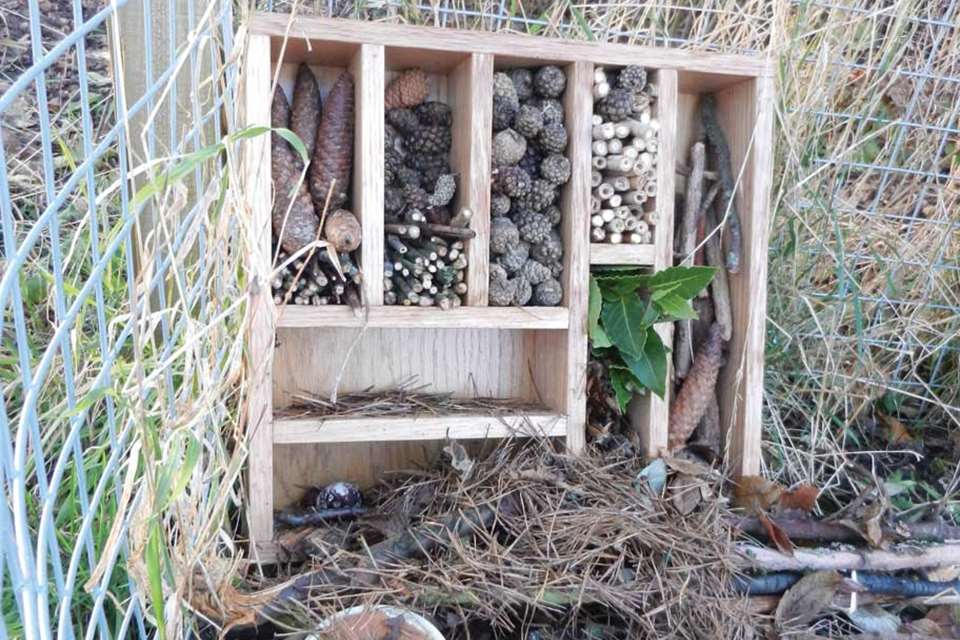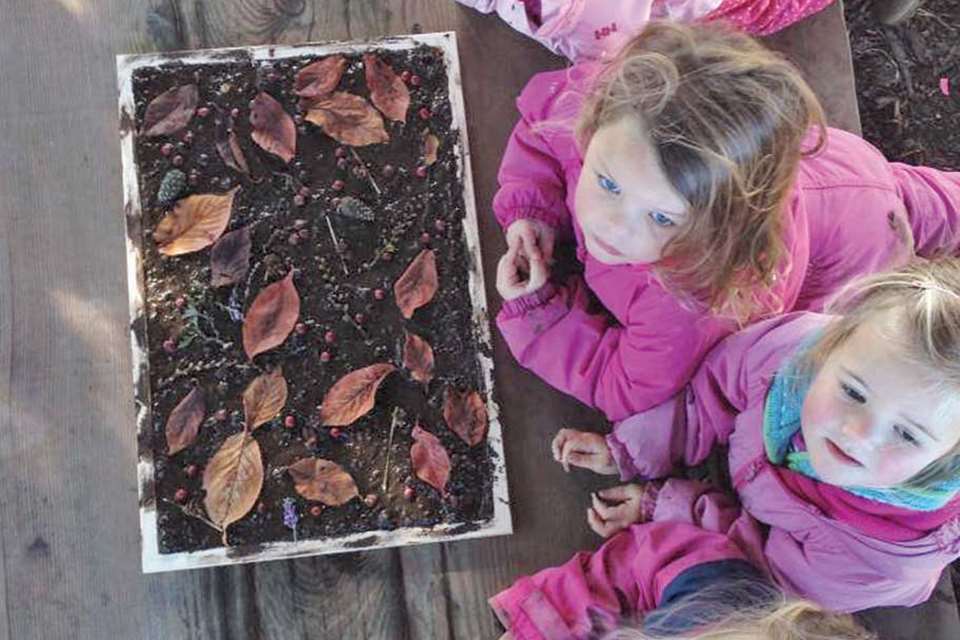Enabling Environments: Outdoors - Character building
Julie Mountain
Monday, April 7, 2014
In the first of a four-part series on planning your outdoor area,Julie Mountain introduces the '7Cs' approach for enabling high-quality play.

Successful, sustainable outdoor play spaces for young children are rarely the result of happy accident. In 20 years of visiting schools and settings in the UK and abroad, I have found that the most effective spaces exhibit a combination of high-quality (and generously provided) resources, knowledgeable and committed outdoor practitioners, and thoughtfully designed landscapes that provide children with opportunities to manipulate and affect their environment.
Big budgets are rarely as influential as a setting's careful, considerate and consistent commitment to outdoor play. Despite this, UK outdoor spaces for young children are still dominated by spaceand budget-grabbing fixed-play equipment.
This series will explore a different methodology for the design, resourcing and management of early years outdoor spaces: the 7Cs approach, devised by Canadian academics Susan Herrington and Chandra Lesmeister.
Their Outside Criteria research team at the University of British Columbia spent five years studying the physical features and usage patterns of 16 early childhood centres in Vancouver. Their research resulted in the publication of 7Cs: An Informational Guide to Young Children's Outdoor Play Spaces.
THE 7CS MODEL
The 7Cs model introduces new insights to outdoor space design and brings together several of the concepts landscape designers have long considered essential elements of the creation of outdoor spaces for schools and settings.
Outdoor Criteria's 7Cs approach aims to complement current safety guidance and standards, providing fresh evidence about the factors that combine to generate high-quality outdoor play experiences.
The length of the 7Cs research programme enabled the team to delve deep into the personality and routine of the outdoor spaces. They discovered the following.
- Childcare centres that exceeded their densities (that is, insufficient 'free' space per child outdoors) experienced more aggression between children.
- Aggression between children increased when no manipulable material was provided outdoors.
- Centres with equipment purchased in the preceding six years had less space for 'non-equipment' play.
- Fixed play equipment (for example, a climbing structure) was unoccupied for 87 per cent of the time. Of the remaining 13 per cent of time, only three per cent was spent using the structure in the way the manufacturer had intended.
- Contact with living things increased developmental opportunities for children.
- There was no discernible relationship between the themes created by manufacturers or designers and children's own imaginative play.
- The materials the play space was made from influenced the 'soundscape', which in turn affected stress levels in children.
- Children want more soft spaces, indoors and outdoors.
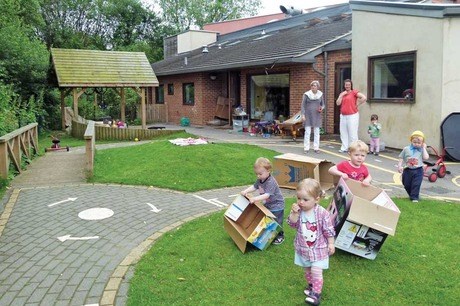
WHAT ARE THE 7CS?
The 7Cs research is not intended as a 'tick list' for designers or practitioners. The Cs are all interconnected, with the character of a space significantly influenced by the other six Cs.
Character: the atmosphere, or 'feel' of the space; character is influenced by each of the following six Cs.
Context: how the immediate locality, external factors such as microclimate and the relationship between the building and the garden spaces affect the quality of the space.
Connectivity: the 'accessibility' of the space - how easily children are able to move around it, see through it and into it and how they understand the area as a coherent setting for play.
Change: the landscape should include open and private spaces, differently sized areas and places of varying levels and heights. The space should look different each day, each season, each year.
Chance: the opportunity for spontaneity and manipulation. Children should be able to affect their play space with open-ended resources and a landscape that lends itself to adaptation.
Clarity: the 'legibility' of the space, which includes the scale of any fixed features and the perceptions children retain of 'their' space. Entrances and exits should be clear and the space should allow for free movement.
Challenge: this refers not just to physical challenges, but also to the intellectual and emotional risks the space enables children to take.
FACTORS AFFECTING QUALITY
The study involved 16 full daycare centres in Vancouver, chosen to represent a distinct cross-section of settings - urban, suburban and semi-rural; new, refurbished and adapted - and to represent the rich diversity of cultural and socio-economic groups resident in the greater Vancouver area.
The research comprised observations, photographic surveys, focused interviews and reflection on polices and standards that shape outdoor spaces for young children. The outcomes of other studies that documented the qualities of outdoor play spaces for young children were also included.
The research team identified five factors that influence the quality of outdoor play. They examined the prevalence of these in the 16 study settings and drew conclusions about the effect they had on children's well-being. The factors were as follows.
- The size of the space, and where children played within this space. It became clear that while the amount of space 'allocated' to each child had remained constant over the past 30 years, the quantity of space allocated to fixed play equipment (and its inevitable safer surfacing) had increased, meaning less 'free' space for children to engage in gross motor play. In tandem with this development, it became apparent that lack of gross motor play was contributing to worryingly high levels of childhood obesity.
- The relationship between types of play and the nature of the space the play was occurring in. Nursery World readers will be familiar with the taxonomy of play, but the 7Cs research also looked at the duration of play in different environments and noted where the play was child-initiated, adult-led or a combination of both.
- Children's and adults' perceptions of the space, both during the study period and the longer-term impressions gained by users over the lifetime of their connection with the setting. Research by educational charity Learning through Landscapes demonstrated that the quality of the environment had a direct impact on children's self-esteem and motivation to learn and this is now a widely understood phenomenon 1.
- The presence of natural living things in the environment.
Again, research suggests that children feel a deep connection with the eternally changing natural world and are keen to share what they see and understand with adults and other children.
At Swansea Metropolitan University, Jane Waters found that 'natural landscapes afforded engagement with the environment and with the practitioners' and that 'children are drawn to particular features of the landscapes and are willing and eager to share their interests with staff and other children' 2. 7Cs backed up this premise.
- The availability and quantity of materials children can control and manipulate, such as sand, water, gravel and mud. The desire to experiment and explore is innate in young children and the most successful spaces offered opportunities to dig, transport, spill, throw and collect.
If you plan to examine the quality of outdoor play at your setting, these five factors would make an excellent launch point. Detail and clarity about your 'baseline' conditions will help refine your improvement priorities. This in turn will justify the time and money spent on the outdoor space project.
THE FIRST 'C': CHARACTER 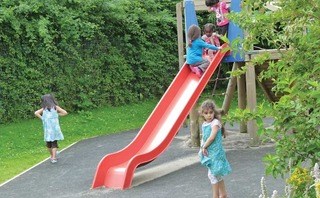
The character of the space describes its 'overall feel' and is very much a subjective judgement. The 7Cs team identified four distinct architectural types that also strongly influence the atmosphere outdoors.
- Modern – the design reflects the 'infrastructure and mechanisms of the landscape and building'.
- Organic — the space contains materials children can manipulate and is characterised by changing landscape features.
- Modular — whereby equipment dominates the space, leaving limited 'free' space for play.
- Re-use — where the space is adapted from some other purpose, not originally intended for play.
If you had to describe the character of your outdoor space in one (shortish) sentence, what would you say? Does your garden reflect the ethos and approach of your setting, or the knowledge and experience of your staff? Do the features, resources and landscaping outdoors support children's developmental milestones?
Character is affected by a multitude of physical factors such as the size of the space, the number of children using it, the prevalence of natural materials and the location of fixed features. However, it is important to point out here that the adult role is vital in any early childhood environment, indoors or out. Adults have a pivotal effect on children's perceptions about the character of their space and where they have worked collaboratively to accurately identify needs of young children - and gaps in the provision of these - the character of the resulting play spaces is seen to be deeply engaging and compelling.
In her book, Playing and Learning Outdoors (2014), outdoor play advocate Jan White suggests that the adult role is 'critical' to the provision of high-quality outdoor play, and while the 7Cs guidance is very much focused on how the physical environment affects the quality of play, it clearly supports the widely held view that 'knowledgeable and enthusiastic adults are crucial to unlocking the potential of outdoors' 3.
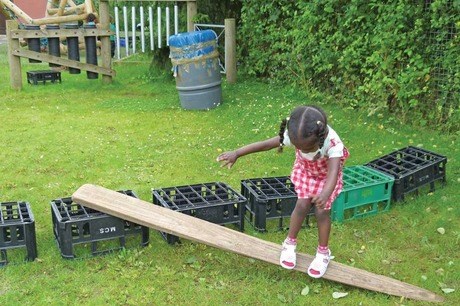
CASE STUDY: IN PRACTICE
While the building itself is undoubtedly modern, the 'character' of the outdoor spaces at Grandpont Nursery School and Children's Centre would be described by the 7Cs team as 'organic'. That definition states that 'the design highlights the changing outdoor environment and includes materials children can manipulate'.
Close to Oxford city centre and serving a richly diverse local population, Grandpont nevertheless benefits from open land on three sides, meaning that trees and shrubs border the outdoor spaces.
A small 'woodland', known as The Hundred Acre Wood, and the combination of built and natural features provides privacy for play, but also adds a much-valued natural landscape to the lives of the children and families using the centre.
When children are outdoors, the space feels 'busy' and 'purposeful', but not 'hectic' or 'cramped'. This is primarily because the available space isn't dominated by fixed play equipment. There are climbing structures, but the main one is tucked away towards the perimeter of the site and instead the focus of the three-to-fives area is a large, multi-level sandpit.
Birth to three
In the birth-to-threes area, the key features are a covered sand and gravel area and grassy mounds. Here, children have plenty of space to move freely and are able to manipulate and build, be noisy, be messy and be independent.
Circulation around the space has been carefully considered and children are able to manoeuvre themselves, and any awkward or wheeled objects, into almost every nook and cranny - of which there are many. The space can be manipulated and changed by children and the 'character' of the outdoors speaks strongly of the child-centred, Reggio inspired philosophy that drives the work at Grandpont.
Annie Davy was early years lead for Oxfordshire County Council for many years and has worked extensively with the staff team at Grandpont. She notes that, 'A very respectful ethos is apparent there. Staff are respectful of children and of parents and it's clear that change is in response to children's needs.'
Loose parts
While loose parts resources abound outdoors at Grandpont, Ms Davy points out that 'staff choose high-quality resources and help children learn how to value and care for them.' Quality of resources is as important as quantity and has as great an impact on the 'character' of a space as its fixed features and landscaping do.
Staff have worked on their own attitudes to risk and challenge, recognising that they could offer more; there is an understanding that no space should remain static and that it should be possible to 're-invent' outdoor provision to meet the needs of changing cohorts of children.
These revisions and alterations are allowed for by the key features of the outdoor space at Grandpont: nature is present and changes daily, weekly, seasonally; there are elements that children will always want to experience - water, mud, prospect and seclusion; and there are fixed features around which other activities can take place - the sandpit, climbing frame, storage shed, mud kitchen and agility trail.
Headteacher Anna Gillespie explains, 'Our spacious garden is structured as larger open areas and smaller spaces and enables children's exploratory play. It is full of winding paths, a variety of surfaces and levels with natural and man-made materials. It is organised for open-ended play, with open-ended resources and a huge sandpit at the centre.'
The combination of abundant, high-quality resources, thoughtful landscape design and passionate outdoor practice characterises the outdoor space at Grandpont Nursery and Children's Centre.
MORE INFORMATION
- Each article in this series is accompanied by a guidance note, aimed at helping settings apply the 7Cs principles to their own circumstances. See below to download the corresponding guidance. The guidance for this feature focuses on helping you assess the character of your outdoor space.
- The 7Cs guide, by Susan Herrington, Chandra Lesmeister, Jamie Nicholls and Kate Stefiuk, can be downloaded at www.wstcoast.org/playspaces/outsidecriteria/7Cs.pdf
FOOTNOTES
1 Research includes Special Places, Special People by Wendy Titman (1996); Childhood's Domain: Play and Place in Child Development by Robin Moore (1986)
2 Research includes Sowing the Seeds: Reconnecting London's Children with Nature by Tim Gill (2011); Learning in the Outdoor Environment: a missed opportunity? by Jane Waters and Trisha Maynard (2006)
3 Shared Vision and Values for Outdoor Play in the Early Years, Vision and Values Partnership (2004).




